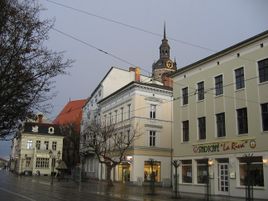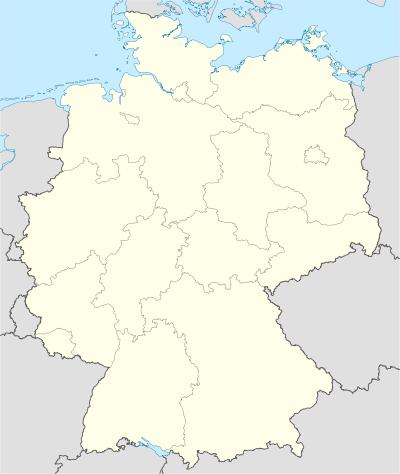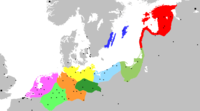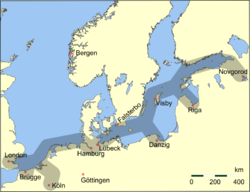Brandenburg an der Havel
| Brandenburg an der Havel | |
 |
|
 |
|
 Brandenburg an der Havel
|
|
| Coordinates | |
| Administration | |
| Country | Germany |
|---|---|
| State | Brandenburg |
| District | Urban district |
| Lord Mayor | Dr. Dietlind Tiemann (CDU) |
| Basic statistics | |
| Area | 228.80 km2 (88.34 sq mi) |
| Elevation | 32 m (105 ft) |
| Population | 72,264 (31 December 2009)[1] |
| - Density | 316 /km2 (818 /sq mi) |
| Other information | |
| Time zone | CET/CEST (UTC+1/+2) |
| Licence plate | BRB |
| Postal codes | 14772–14778 |
| Area code | 03381 |
| Website | www.stadt-brandenburg.de |

Brandenburg an der Havel, locally called "Brandenburg anna Havel", is a town in the state of Brandenburg, Germany. It is located on the banks of the Havel river. Population: 74,129 (December 31, 2005).
The town of Brandenburg, which is almost as widely known as the state of Brandenburg, provided the name for the medieval Bishopric of Brandenburg, the Margraviate of Brandenburg, and the current state of Brandenburg. Today it is a small town compared to nearby Berlin, but it was the original nucleus of the former realms of Brandenburg and Prussia.
Contents |
History
The castle of Brandenburg, which had been a fortress of the Slavic tribe Stodoranie, was conquered in 929 by King Henry the Fowler. The town remained German only until 983, when a Slavic rebellion was successful. During the next 170 years the area was ruled by Slavic princes of the Hevelles tribe. The last of them, Pribislav, died in 1150. Afterwards Albert I settled here and became the first margrave of Brandenburg. The town was restricted to the western bank of the Havel until 1196, when it was extended to the eastern side. The parts on either side of the river were regarded as three different towns (Old Town, New Town and Brandenburg cathedral district) for centuries.
In 1314-1315 the Old and New Towns joined the Hanseatic League. In the Thirty Years' War (1618-1648) the towns suffered plundering and destruction which led to a loss of power; Potsdam became the new capital, and the court left the town of Brandenburg. In 1715 Old Town and New Town were merged to form a single town. In 1928 the Brandenburg cathedral district was added.
In the late 19th century Brandenburg an der Havel became a very important industrial center in the German Empire. Steel industries settled there, and several world famous bicycle brands such as Brennabor, Corona and Excelsior were manufactured in the city. A world famous toy industry was also established. With a giant industrial complex, the Deutsche Reichsbahn (German Imperial Railways) was located in Brandenburg-Kirchmöser during the time between the two world wars and the time of the former GDR. The city's excellent infrastructure was a big advantage: the city is located at the junction of Federal Highways 1 and 102, the Autobahn A2 is nearby, the river Havel and the Silo canal serve as European Waterways. The railroad connection between Berlin and Magdeburg also runs through Brandenburg an der Havel.
Nazi era
A concentration camp, one of the first in Germany, was located on Nikolaiplatz in Brandenburg Old Town. After closing this inner city concentration camp, the Nazis used the Brandenburg-Görden Prison, located in Görden, a suburb of Brandenburg. In the Nikolaiplatz camp, the Nazis killed people with mental diseases, including children. They called this operation "Action T4" because of the Berlin address, Tiergartenstraße 4, the headquarters of this planned and well-organized killing "euthanasia" organisation. Brandenburg an der Havel was one of the very first locations in the Third Reich where the Nazis experimented with killing their victims by gas. Here, they prepared the mass killings in Auschwitz and other extermination camps. After complaints by local inhabitants about the smoke, the mobile furnaces used to burn the corpses ceased operation. Shortly after this, the Nazis closed the old prison.
In 1934, the Arado Aircraft Company, which originated in Warnemünde, began building a satellite factory in Brandenburg that began producing planes in 1935. The factory was expanded over the next five years, and during World War II produced trainers and other aircraft for the Luftwaffe. The existence of this factory was one of the reasons Brandenburg was heavily bombed in later stages of the war; by 1945 the city was 70 percent destroyed.
Friedrich Fromm, a German officer involved in the July 20 plot to assassinate Hitler, was executed here in March 1945 for his part in the plot, even though Fromm betrayed those conspirators he knew and ordered their execution.
After the fall of the Berlin Wall the city's population declined from over 100,000 in 1989 to roughly 75,000 in 2005 through emigration. The migration was mainly by young people. As a result, the future of the city is uncertain.
Population statistics
|
|
|
Sights


The Dominsel (Cathedral Island) is the historic heart of the town. Here stands its oldest edifice: the Dom St. Peter und Paul (Cathedral of Saint Peter and Saint Paul). Although construction began in the Romanesque style in 1165, it was completed as a Gothic cathedral during the 14th century. While the exterior is rather austere, the cathedral surprises the visitor with its sumptuous interior, especially the painted vault of the Bunte Kapelle (Coloured Chapel)
The Katharinenkirche (St. Catherine's church) built in 1401 in the Neustadt is an impressive example of northern German brick Gothic architecture. The Gotthardkirche (St. Gotthard's church) was built of the same material just a few years later.
Another interesting building is the Altstädtische Rathaus (Old Town Hall), a late Gothic brick building with stepped gables and an ornate portal. In front of it stands a 5.35m high statue of the knight Roland. Made in sandstone, the statue was erected in 1474 as the sign of the town's independence.
There is also a part of Brandenburg's medieval city wall, with four preserved watchtowers: the Steintorturm and the Mühlentorturm (in Newtown), and the Rathenower Torturm and the Plauer Torturm (in Oldtown).
The Brandenburg Industrial Museum is an Anchor Point of ERIH, The European Route of Industrial Heritage.
Twin Towns
 Ivry-sur-Seine, France
Ivry-sur-Seine, France Kaiserslautern, Germany
Kaiserslautern, Germany Magnitogorsk, Russia
Magnitogorsk, Russia
See also
- Brandenburg Gate in Berlin
- Brandenburg Hauptbahnhof
- Stahl Brandenburg
- Brandenburger SC Süd 05
References
- ↑ "Bevölkerung im Land Brandenburg am 31.12.2009 nach amtsfreien Gemeinden, Ämtern und Gemeinden. Gebietsstand: 31.12.2009" (in German). Amt für Statistik Berlin-Brandenburg. 31 December 2009. http://www.statistik-berlin-brandenburg.de//Publikationen/OTab/2010/OT_A01-04-00_124_200912_BB.pdf.
External links
- (German) Municipal website
- (German) Cathedral of Brandenburg
- (German) City map
- (German) Inner City Brandenburg guide
- Tramway in Brandenburg
|
||||||||
|
||||||||||||||||||||||||||

